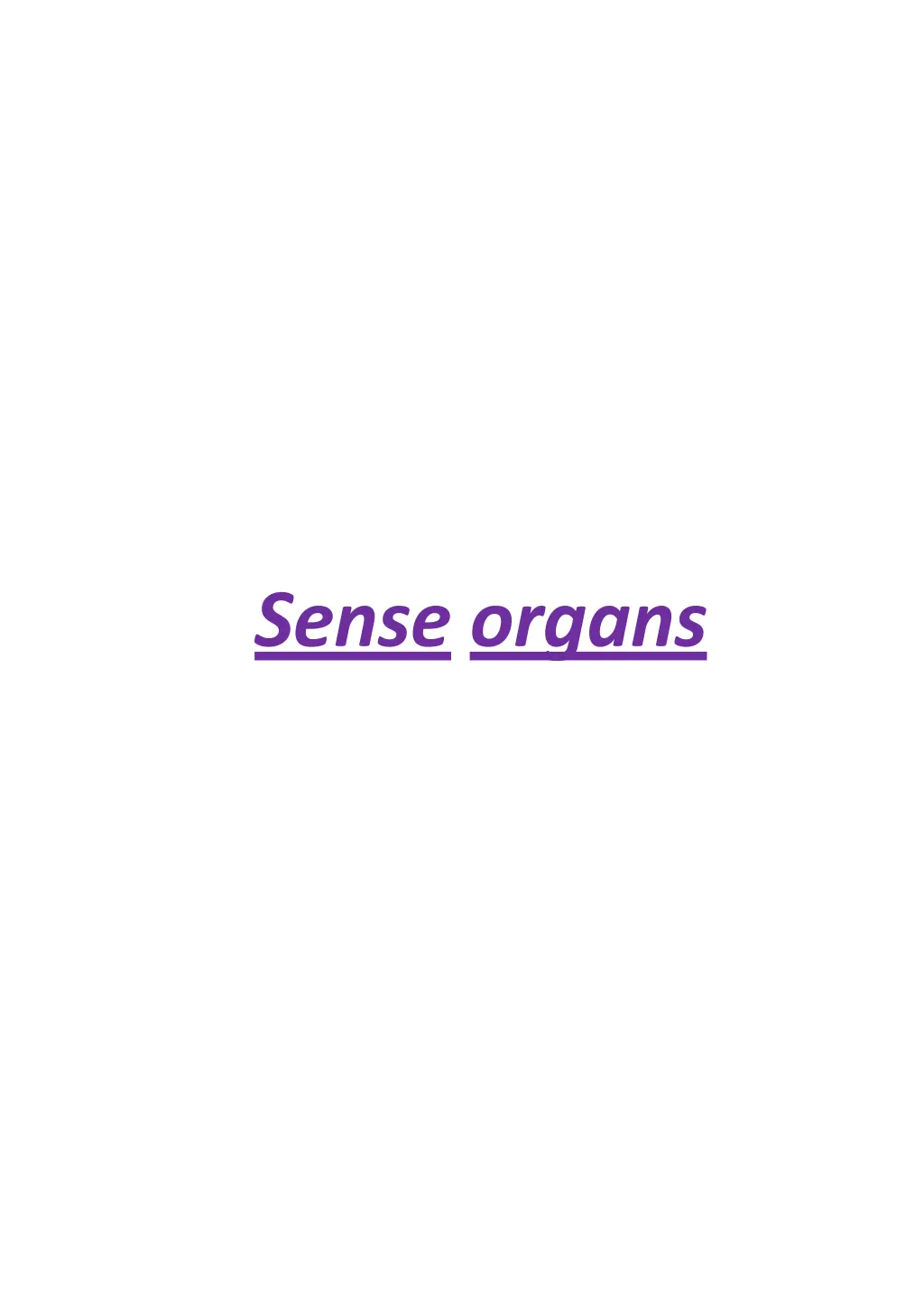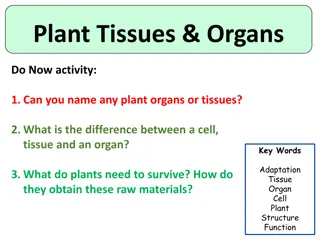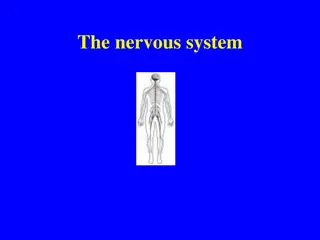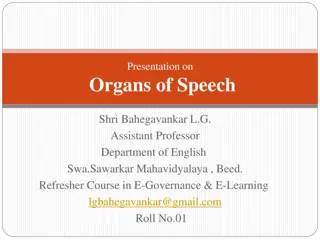
Understanding the Classification of Receptors in Sense Organs
Learn about the classification of receptors in sense organs based on the type of stimuli they respond to, including chemicals, temperature, pressure, and light. Explore the major receptor types in vertebrates and their functions, from olfactory receptors for smell to photoreceptors for detecting visible electromagnetic radiation.
Download Presentation

Please find below an Image/Link to download the presentation.
The content on the website is provided AS IS for your information and personal use only. It may not be sold, licensed, or shared on other websites without obtaining consent from the author. If you encounter any issues during the download, it is possible that the publisher has removed the file from their server.
You are allowed to download the files provided on this website for personal or commercial use, subject to the condition that they are used lawfully. All files are the property of their respective owners.
The content on the website is provided AS IS for your information and personal use only. It may not be sold, licensed, or shared on other websites without obtaining consent from the author.
E N D
Presentation Transcript
Senseorgans Classification of Receptors Classification of receptors by Stimulus: Sensory receptors are primarily classified by the type of stimulus that generates a response in the receptor. Broadly sensory receptors respond to one of the four primary stimuli: 1. Chemicals - chemoreceptors 2. Temperature - thermoreceptors 3. Pressure - mechanoreceptors 4. Light photoreceptors These receptors perform countless functions in our body. During vision, rod & cone photoreceptors respond to light intensity and color. During hearing, mechanoreceptors in hair cells of the inner ear detect vibrations conducted from the eardrum. During taste, sensory neurons in our taste buds detect chemical qualities of our foods including sweetness, bitterness, sourness, saltiness etc. During smell, olfactory receptors recognise molecular features of odors. During touch, mechanoreceptors in the skin and other tissues respond to variations in the pressure.
Major receptor types of vertebrates and their functions: Types of Receptors Names Stimulus 1) Chemical receptors: Olfactory cells Smell Taste buds Taste Free nerve endings Pain, temperature Meissner s corpuscles Touch & pressure Cutaneou s receptors Merkel s disks Touch & pressure Pacinian corpuscles Touch & pressure Ruffini endings Touch & pressure 2) Mechanical, temperature and electrical receptors: Eimer s organs Touch & pressure Sinus hairs Touch & pressure Tendon and joint receptors Tension Proprio- receptors Muscle spindles Degree & rate of contraction Hair cells Vibration & gravity Lateral line, ear & electro- receptors: Ampullary organ cells Electric fields Tuberous organ cells Electric fields Rod & cone cells Visible electromagnetic radiation 3) Photoreceptors and specialized thermoreceptors: "SIMPLE" RECEPTORS (nerve endings in tissues) -Unencapsulated endings in skin, joints, viscera and oral cavity. Classification by encapsulation of nerve endings: Pit organ cells Infrared electromagnetic radiation receptors (mechanoreceptors, thermoreceptors, nociceptors) - free nerve -Encapsulated receptors - tissue-associated nerve endings Pacinian corpuscles in deep dermis, hypodermis, viscera, joint capsules.
Meissners corpuscles in dermal papillae near epidermis. COMPLEX RECEPTORS (special senses) Olfactory, Taste, Labyrinth (equilibrium/balance, hearing), Eye Olfactory receptors in vertebrate Olfactory receptors (ORs), also known as odorant receptors, are expressed in the cell membranes of olfactory receptor neurons and are responsible for the detection of odorants which give rise to the sense of smell. Location: In vertebrates, the olfactory receptors are located in both the cilia and synapses of the olfactory sensory neurons and in the epithelium of the human airway. Mechanism: Rather than binding specific ligands, olfactory receptors display affinity for a range of odor molecules, and conversely a single odorant molecule may bind to a number of olfactory receptors with varying affinities, which depend on physiochemical properties of molecules like their molecular volumes. Once the odorant has bound to the odor receptor, the receptor undergoes structural changes and it binds and activates the olfactory type G protein on the inside of ) ion channels which allow calcium and sodium ions to enter into the cell, depolarizing the olfactory receptor neuron and beginning an action potential which carries the information to the brain.
Fig: 1 Fig: 2 F1: Anatomy of the nasal passage with different parts and olfactory neurons. F2: Molecular pathway of olfaction in the cilia through GPCR.
Auditory receptors in vertebrate In vertebrates, the number of auditory neurons always increases from the periphery (cochlea) to the centre (auditory cortex), by as much as four orders of magnitude. Location and structure: Sensory receptors of hearing are hair cells and associated organ is Organ of Corti present on basilar membrane of cochlea. Colchlea is a coiled structure. It is a bony tube on the outside, and a membranar tube is there on the inside. There is perilymph inside bony labyrinth and endolymph within membranar labyrinth. Perilymphatic space within bony labyrinth is divided in two parallel canals: scala vestibule (SV) and scala tympani (ST), due to presence of endolymphatic canal scala media (SM) (also called cochlear duct). SV and ST are connected at the tip of cochlear coil by a connecting passage named helicotrema. SV and SM are separated by Reissner s membrane while ST and SM are separated by Basilar membrane. Organ of Corti is located on basilar membrane and it is immersed in endolymph of SM (Fig 1 and 2). The vibrations are transferred from SV to ST via helicotrema.
Fig 1: Outline anatomy of ear with different parts. Fig 2: Section of cochlea showing different chambers. Fig 3: Detailed structure of sensory part of cochlea showing hair cells (see mirror image of box portion of Fig 2).
Mechanism: The inner ear consists of the cochlea, which is a spiral-shaped, fluid-filled tube . It is divided lengthwise by the organ of Corti, which is the main organ of mechanical to neural transduction. Inside the organ of Corti is the basilar membrane, a structure that vibrates when waves from the middle ear propagate through the cochlear fluid endolymph. The basilar membrane is tonotopic, so that each frequency has a characteristic place of resonance along it. Characteristic frequencies are high at the basal entrance to the cochlea, and low at the apex. Basilar membrane motion causes depolarization of the hair cells, specialized auditory receptors located within the organ of Corti . While the hair cells do not produce action potentials themselves, they release neurotransmitter at synapses with the fibers of the auditory nerve, which does produce action potentials. In this way, the patterns of oscillations on the basilar membrane are converted to spatiotemporal patterns of firings which transmit information about the sound to the brainstem.






















